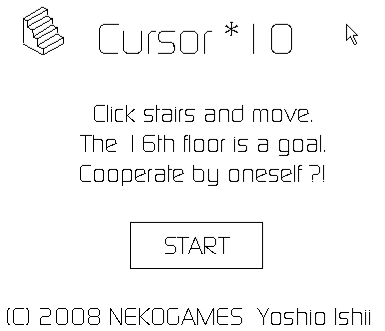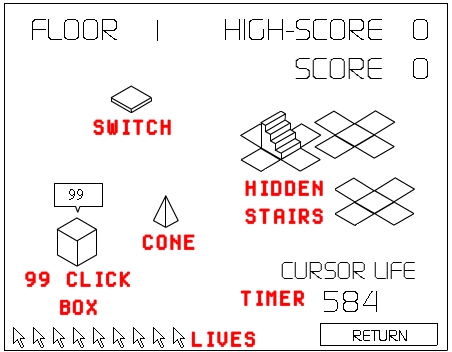Cursor*10 FTW: Give Yourself A Hand
 Sunday, January 4, 2009 at 3:06PM
Sunday, January 4, 2009 at 3:06PM Cursor*10, like I wish I were the Moon, is a game that is very simple. With a graphical style that is reminiscent of Echochrome, Cursor*10 has no sound effects, no music, no enemies, and only one goal.

The objective is presented up front on the title screen.
There are 3 major elements that make this game work so well. Play it here before continuing if you haven't already.

1) According folded level design. As the title implies, the player is given 10 cursors/chances/lives to reach the 16th floor. Each cursor starts on floor 1 and must do everything it can to reach the last floor including opening boxes, ascending stairs, and holding switches all by clicking the mouse. All of the clicks and movements of the previous cursors are recorded and reproduced every time a cursor starts from floor one. In this way, the player uses the cursors to explore the game world while gathering knowledge and making decisions with multitasking in mind. This facet of the level design wouldn't be as excellently pronounced in the gameplay experience if it weren't for the...
2) Clock based cursor timer. Each cursor has 700 ticks of the game clock to do everything it can to reach the 16th floor. It quickly becomes apparent that each second is precious. With 10 chances to make it happen and seconds to do so at a time, the player must act and act quickly. Without giving the player the leisure of playing at their own pace, players must make decisions/moves quickly and therefore learn more quickly. By the 5th cursor, all of the player's cursory actions can be seen operating all at once like a team of historically accurate ghosts. Yet, these "ghosts" collectively layer together working for the future goal.
3) Cones... or should I say coins. Clicking these conic objects isn't necessary to reach the goal. Therefore, going after them is a way for players to control their own difficulty. Collect them all if you want. The beauty of the cone implementation is in how the player must balance time, space, while assigning roles. When a player understands the limitations of a cursor, possibilities open up for that cursor to click cones in the meantime. Though each floor is simply designed, the cones add a layer of potential action to the layered multitasking.
Two additional things that are worth nothing about Cursor*10 are...
- The ascending stairs on floor 4 is randomly placed in one of the 13 boxes. Unless you're lucky, on your first pass through floor 4, time is used up finding the box that contains the stairs. Such a design emphasises how one cursor can't do it alone and that going for the goal naturally creates different roles from the various ways to play the game.
- Clicking all of the cones is one way to get increase the challenge of this game and go for a high score. What's interesting about Cursor*10 is that players can go for the high score while shooting for the lowest time. In this case, the play time is quantified by the number of cursors used. Speed runs like this one are already on youtube.
Many have labeled Cursor*10 as a cooperative puzzle game. But once you understand the core design of this indie game, it's easy to see that it's simply a very clean and clever single player action game. More than one human player is necessary for cooperative play. And even the tricky switch on floor 6 that unlocks the final floor isn't enough to make Cursor*10 a puzzle game. Perhaps with more variegated implementation of the hidden switch design, the game could become a puzzler. But as it is now, the game isn't about the focused nuanced use of the game mechanic CLICK (the only mechanic in the game).
The core design of Cursor*10 is structurally similar to that of the Temple of the Ocean King in The Legend of Zelda: Phantom Hourglass in how the thoughts and actions of the past (previous plays) influence the present gameplay in a limited, folded space. You can read all about that here. Such a comparison is high praise for Cursor*10.
Yokudekimashita, Yoshio Ishii


Reader Comments